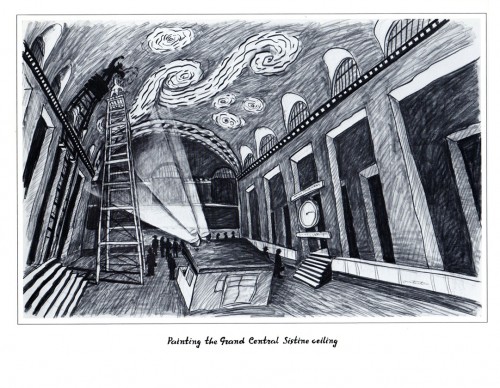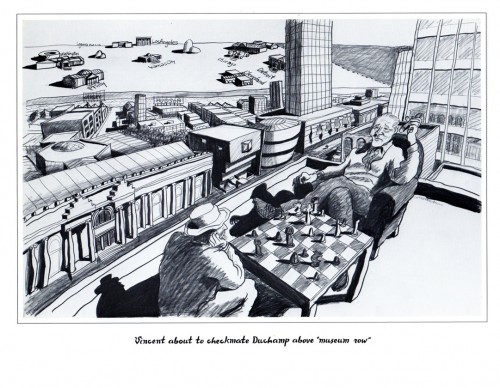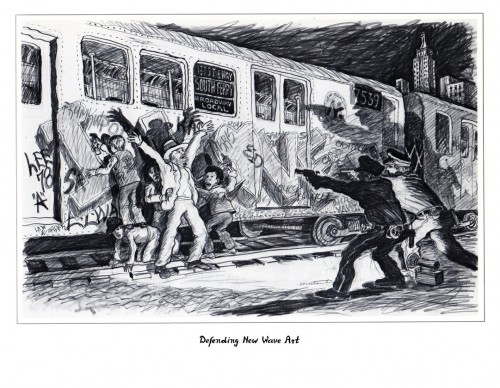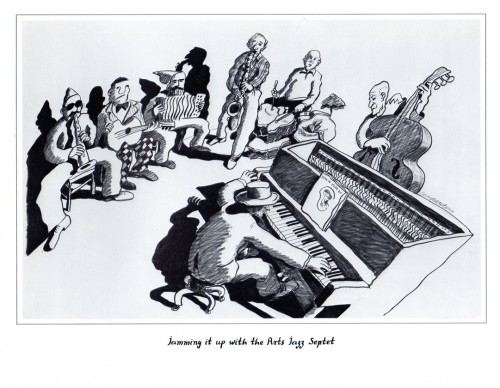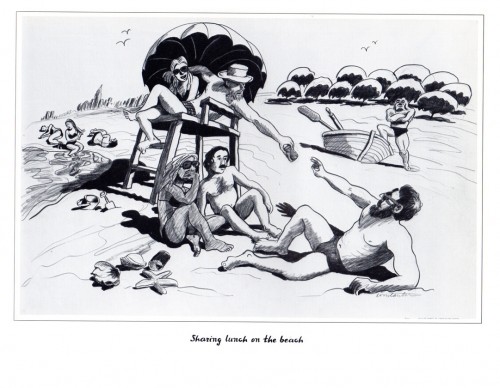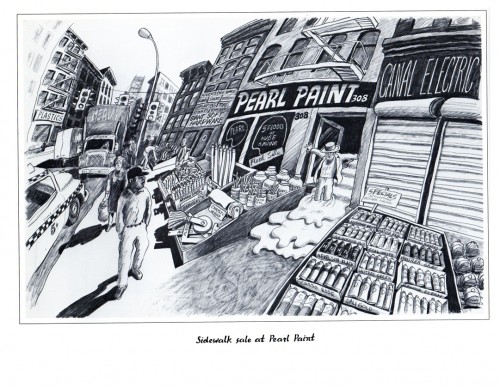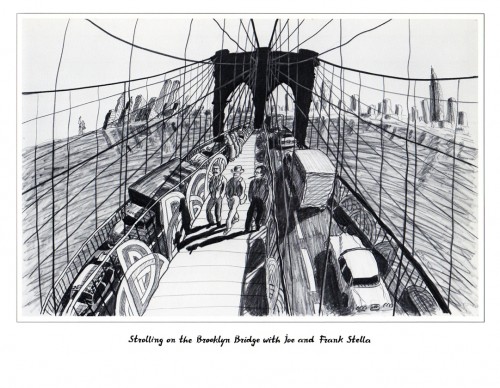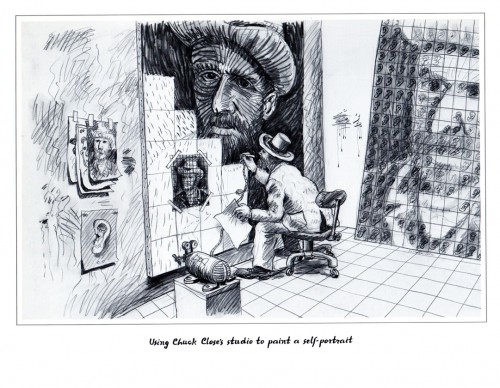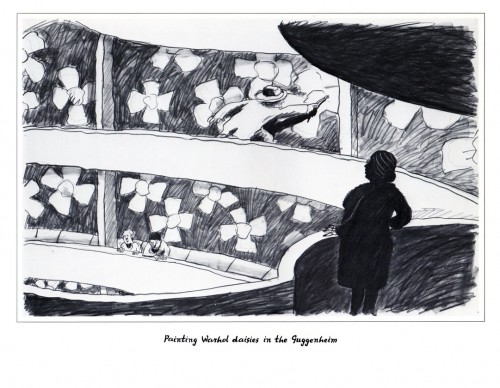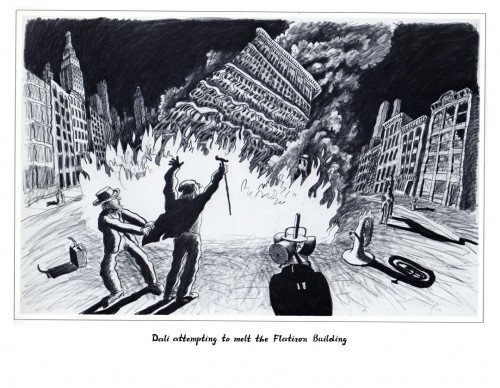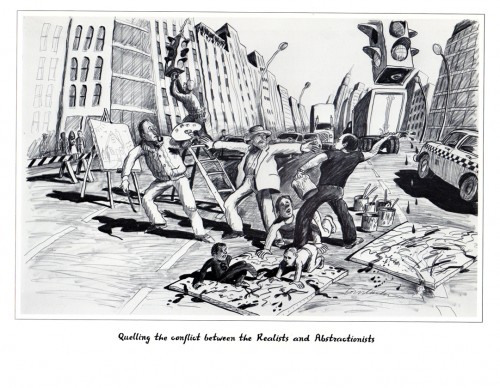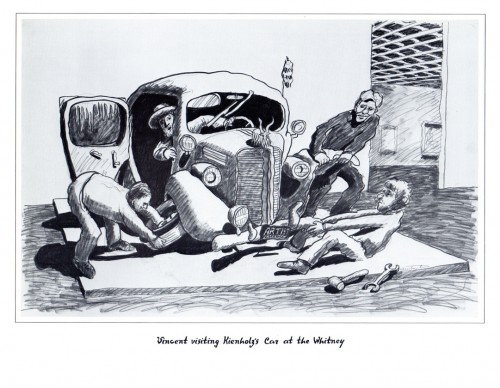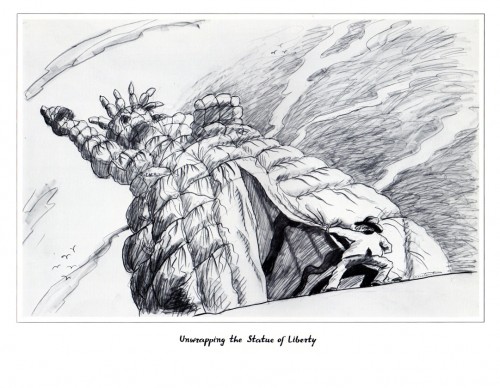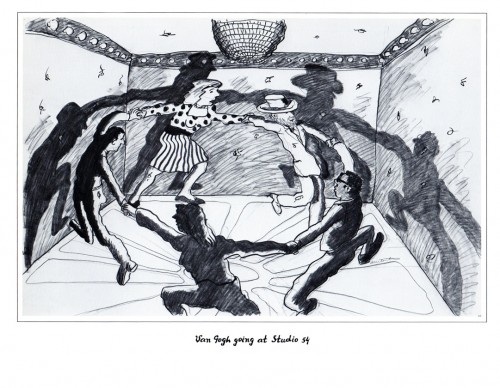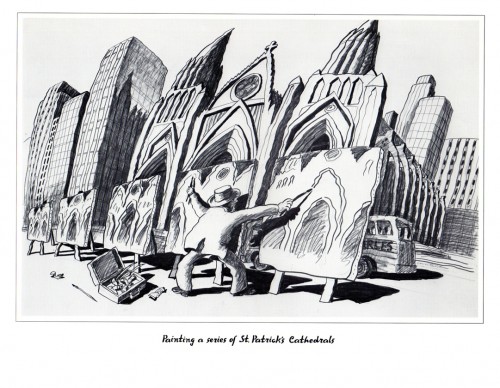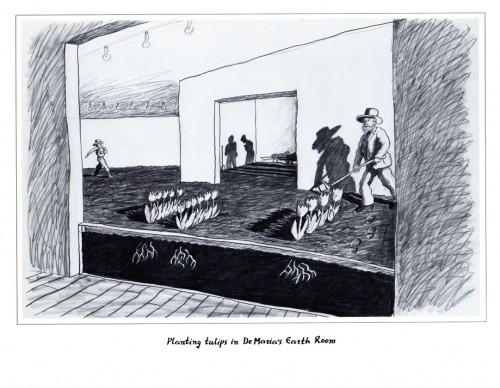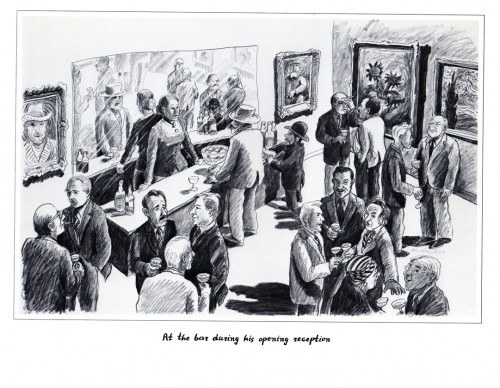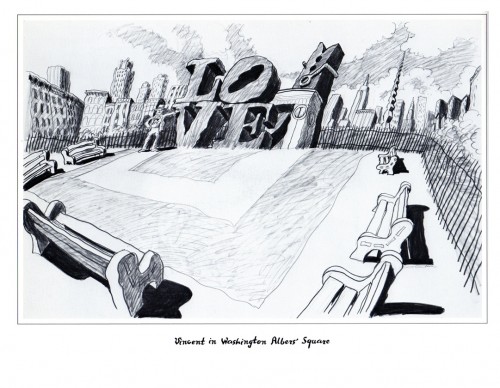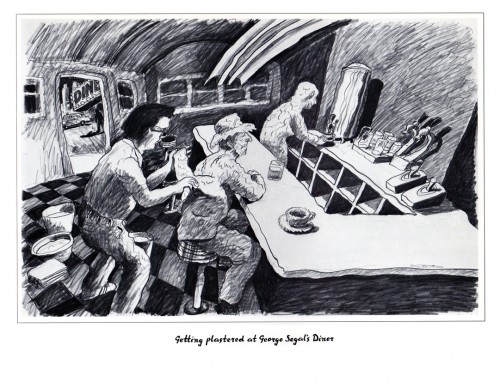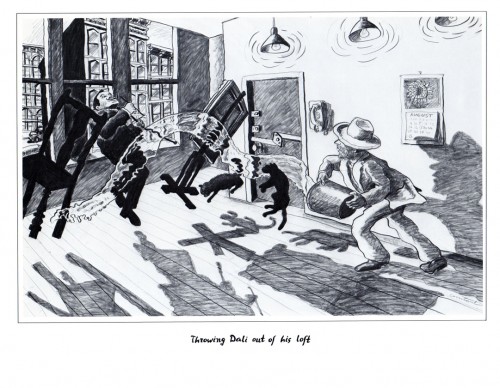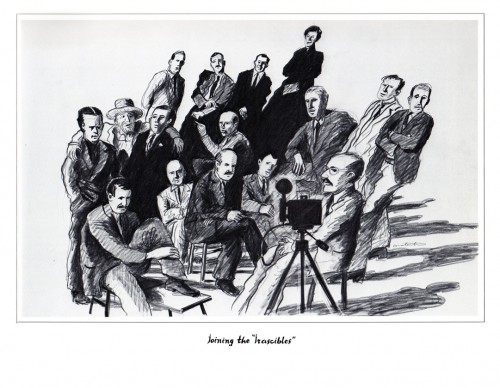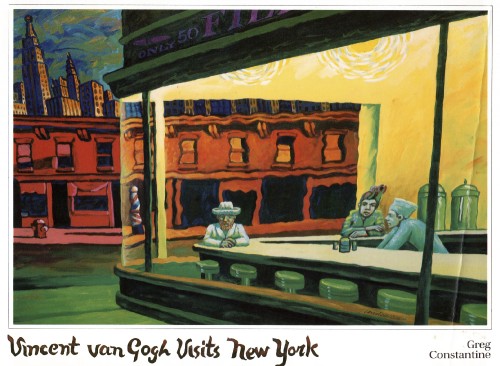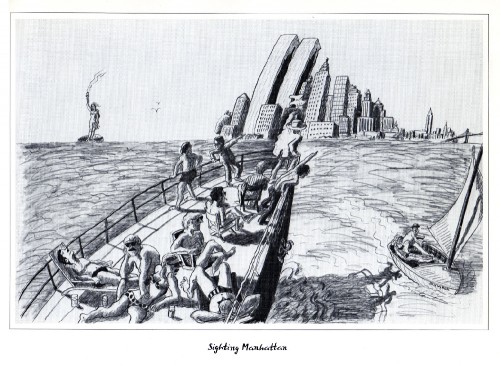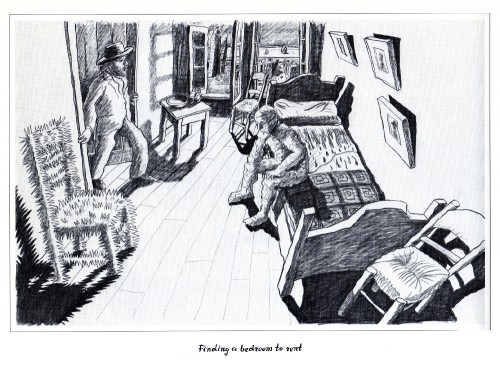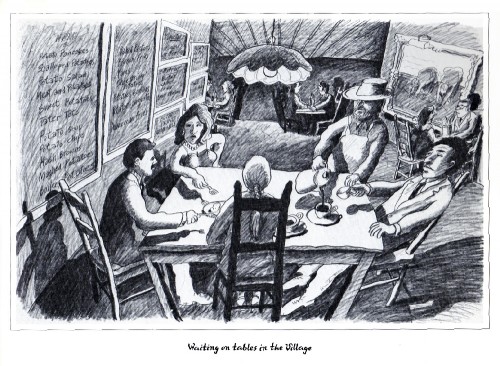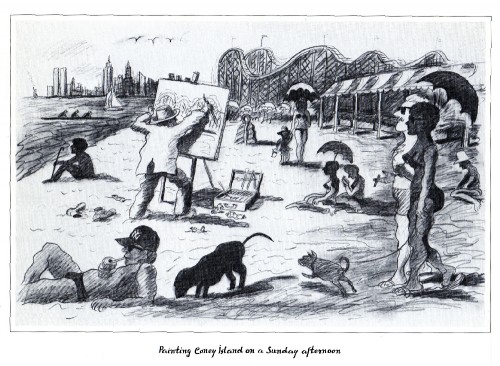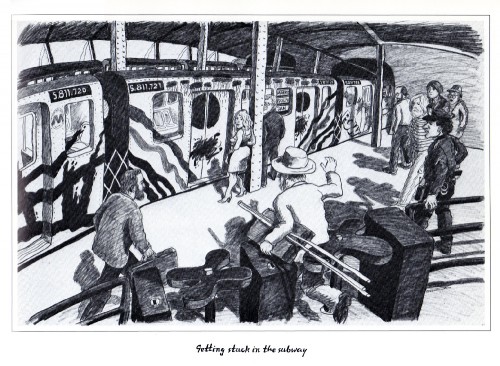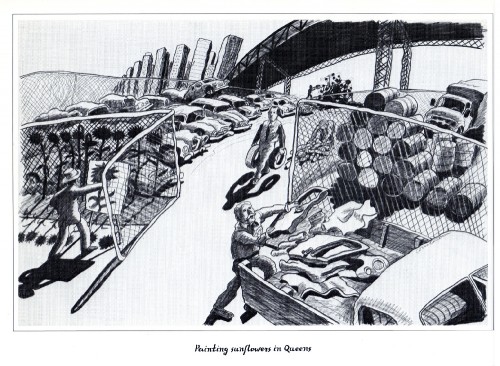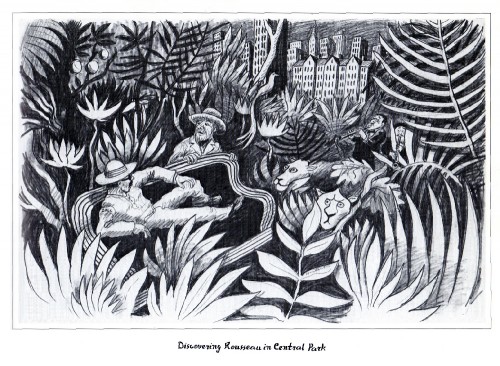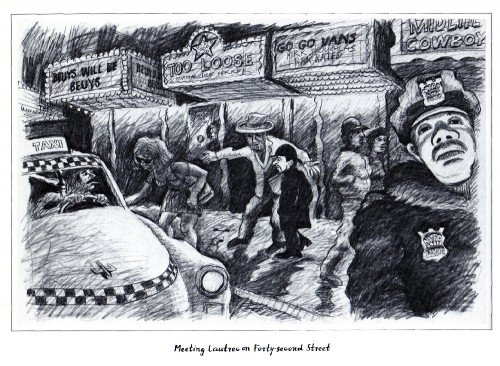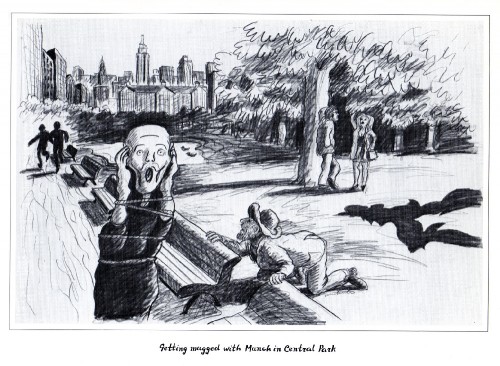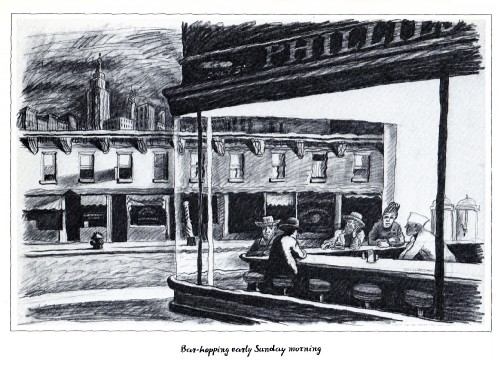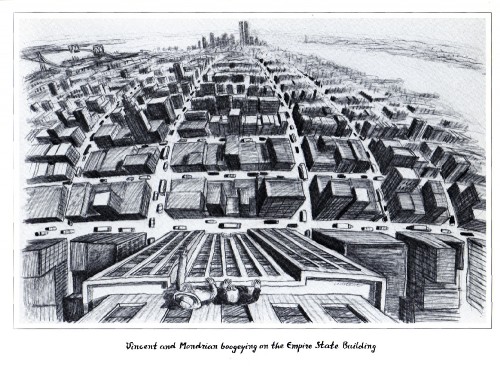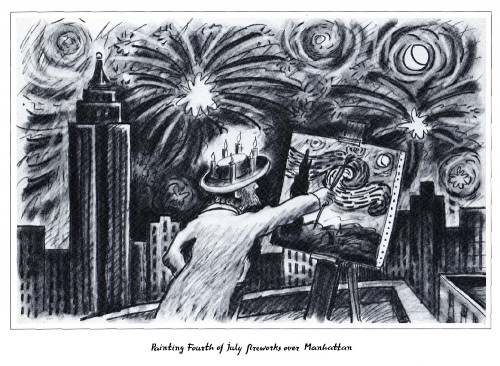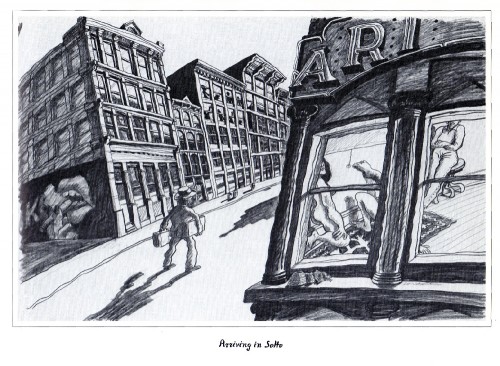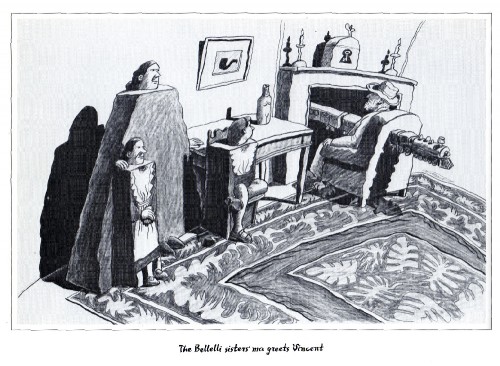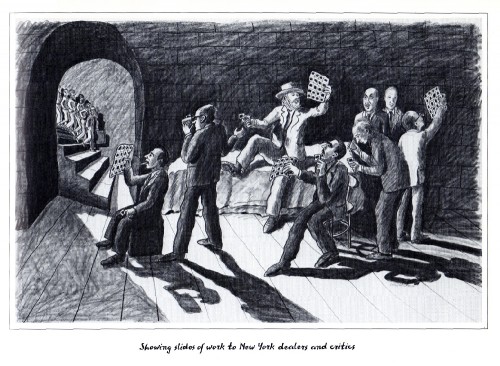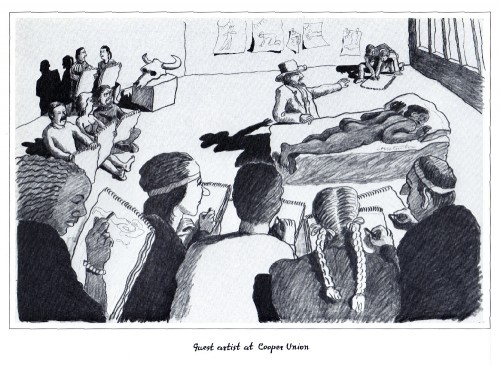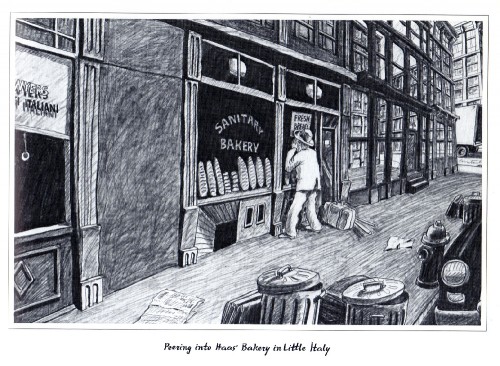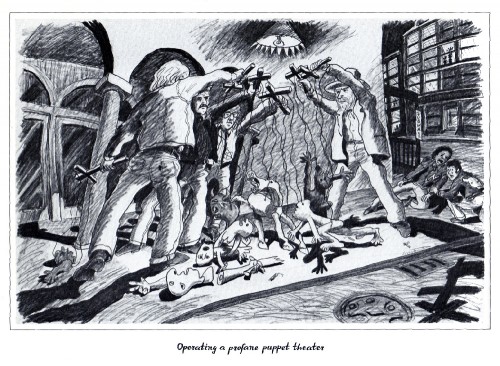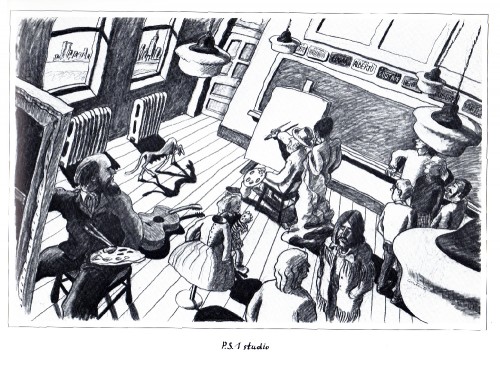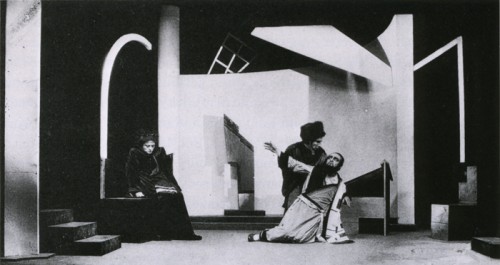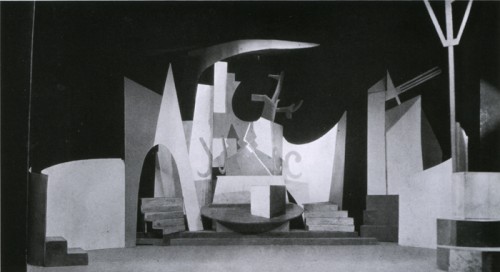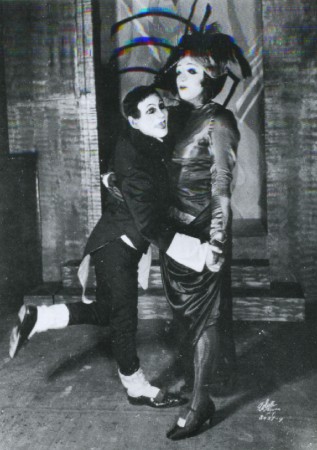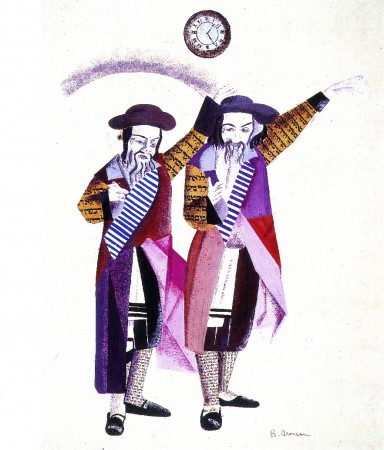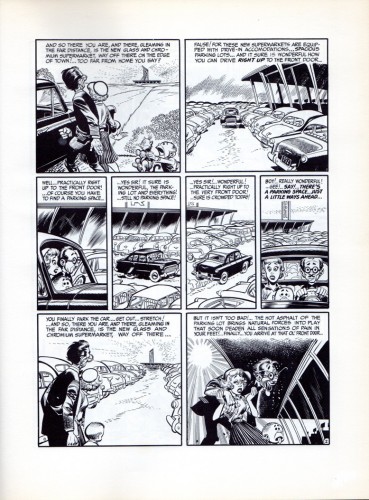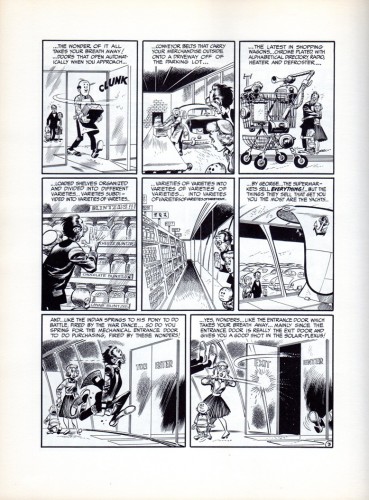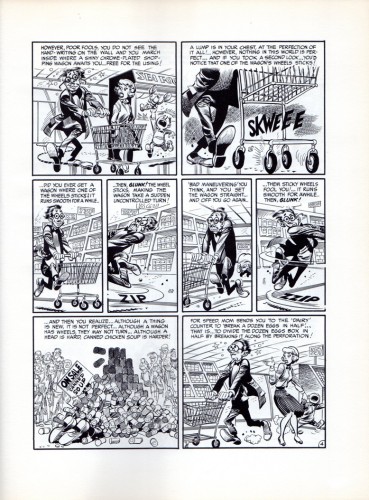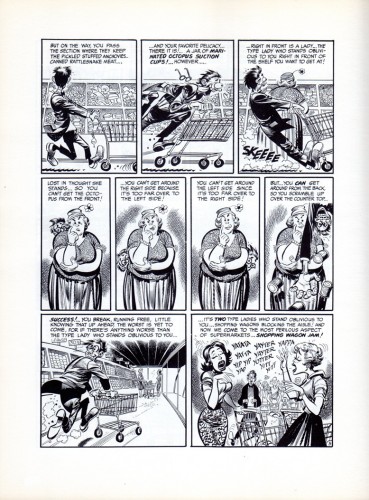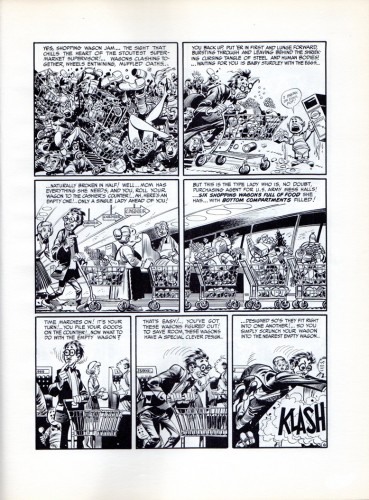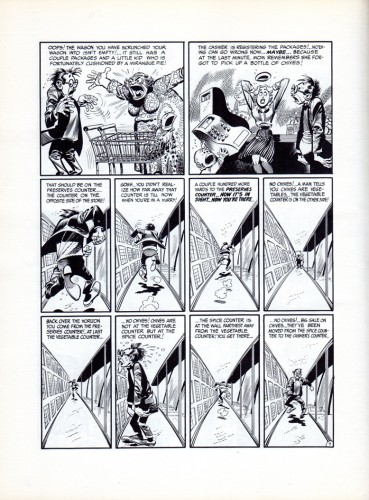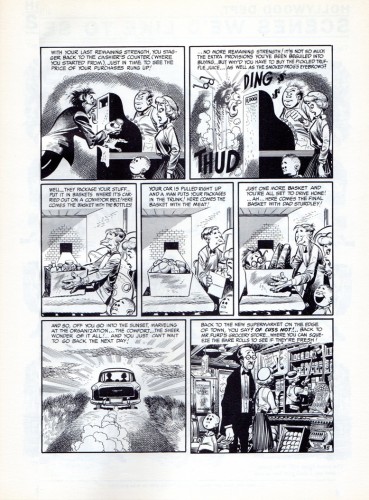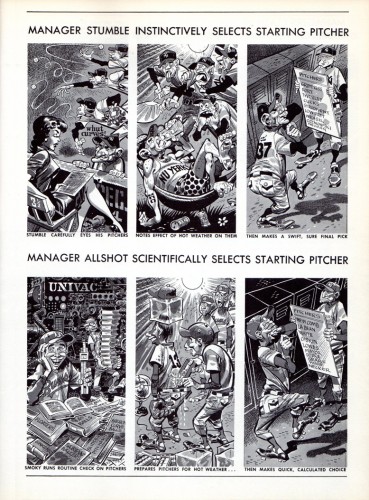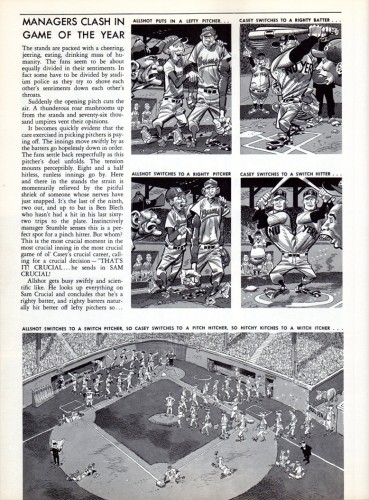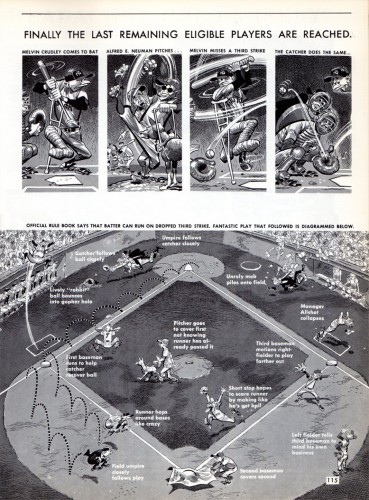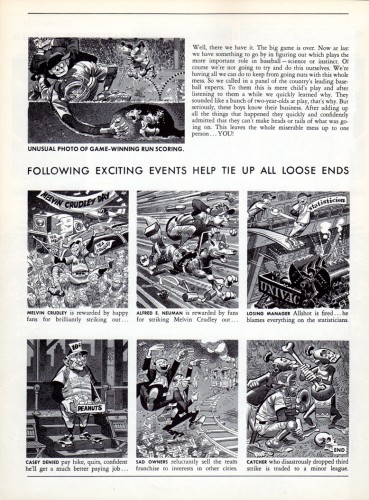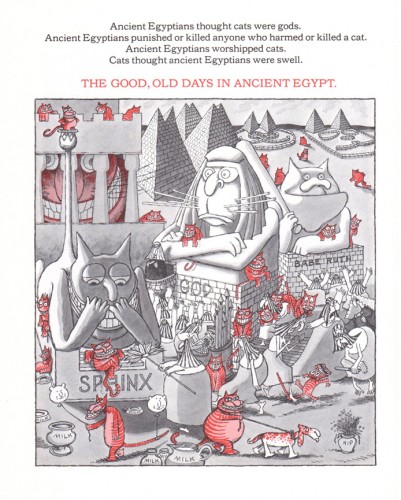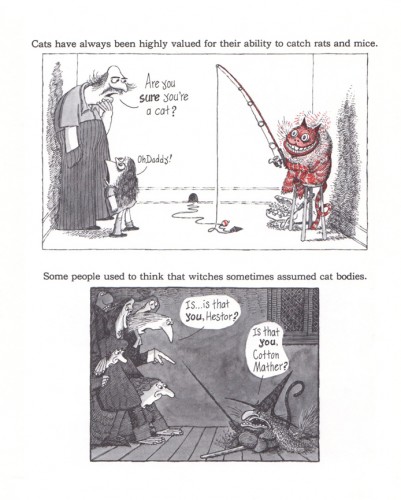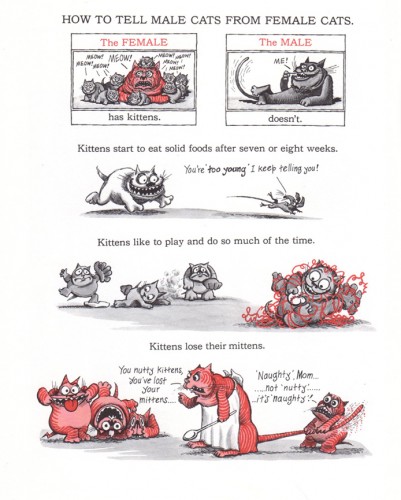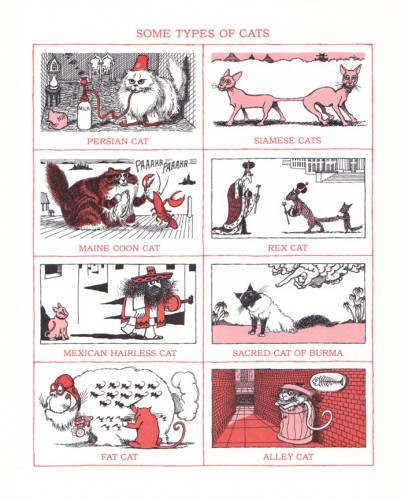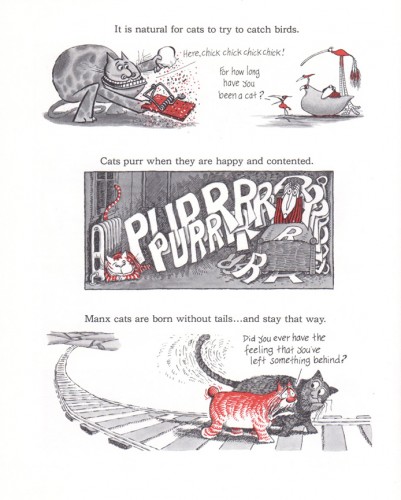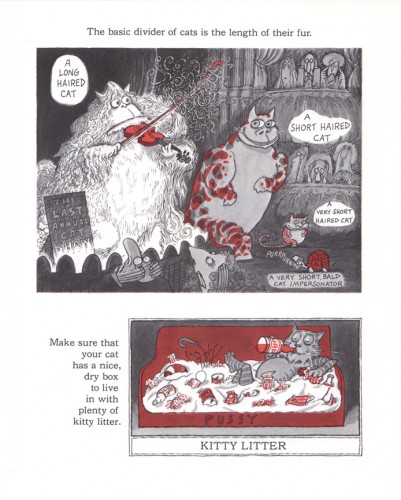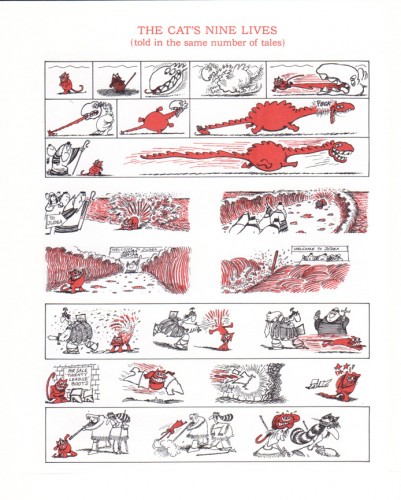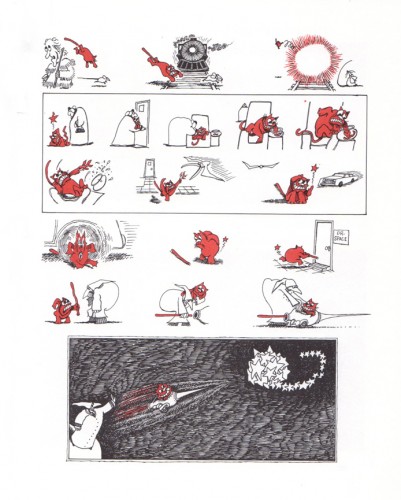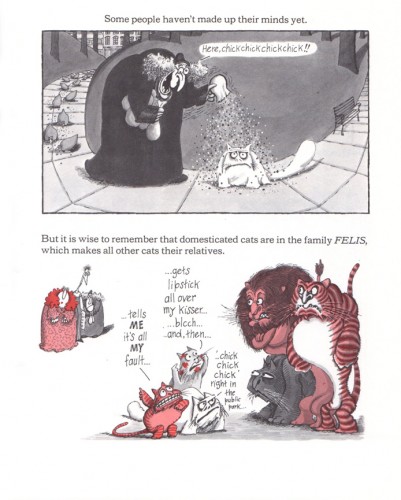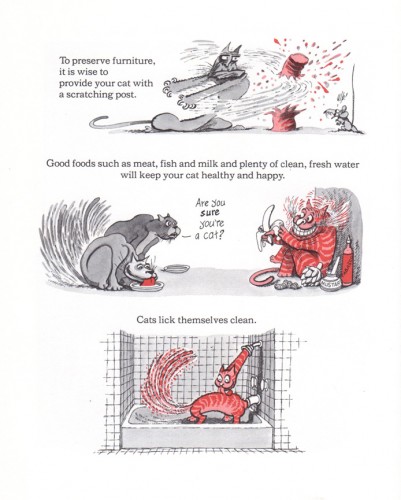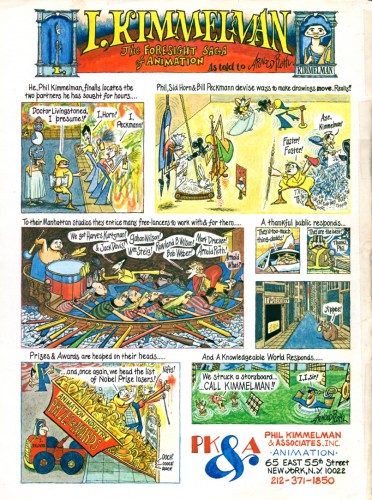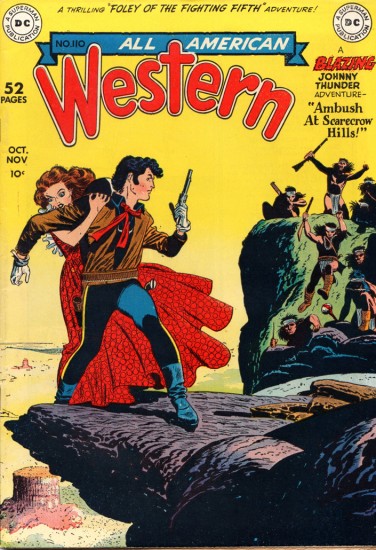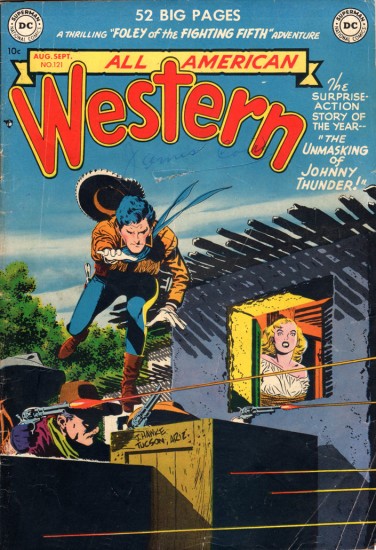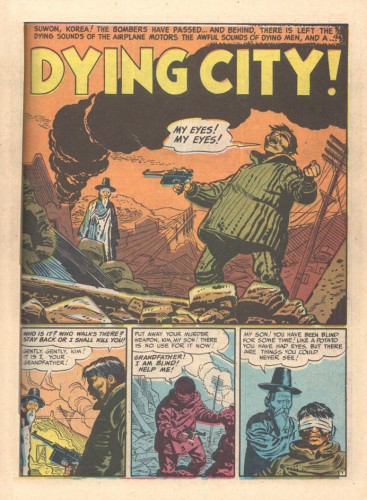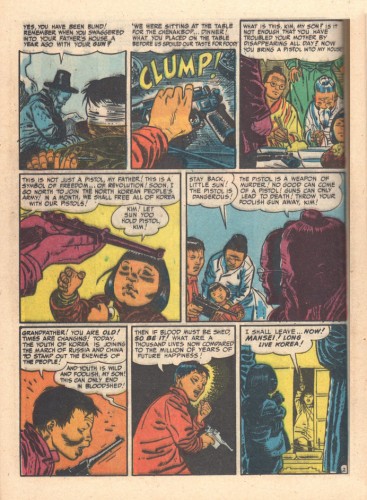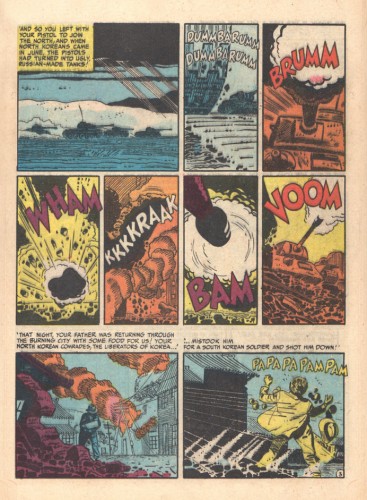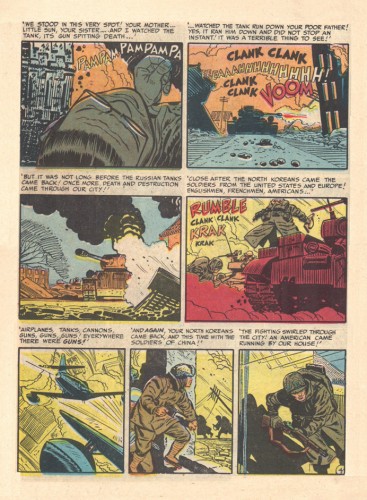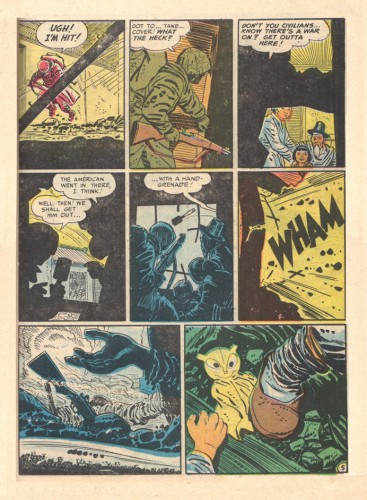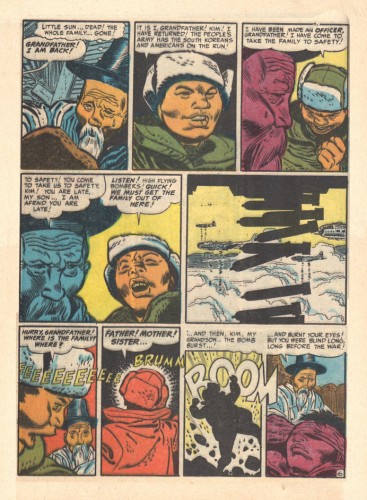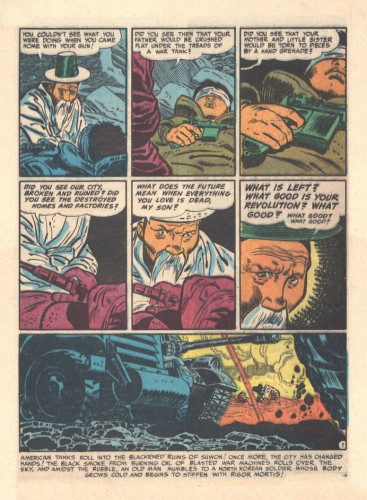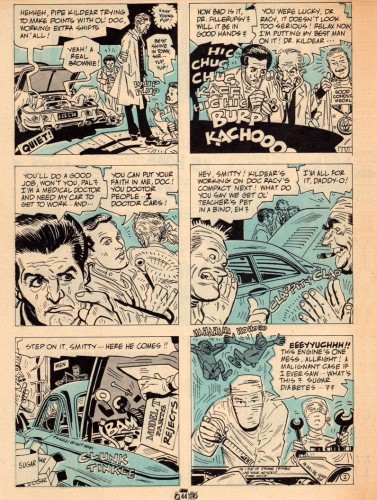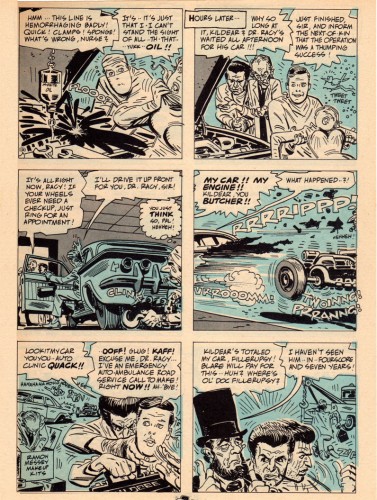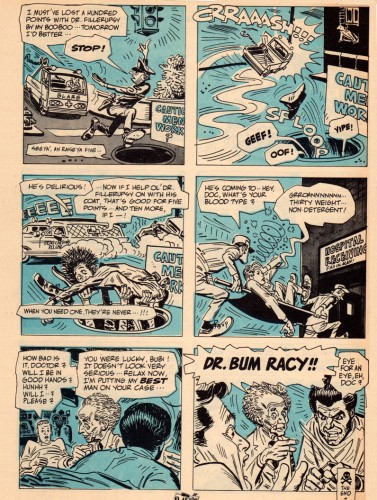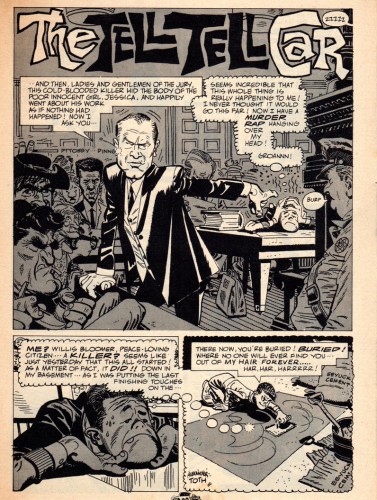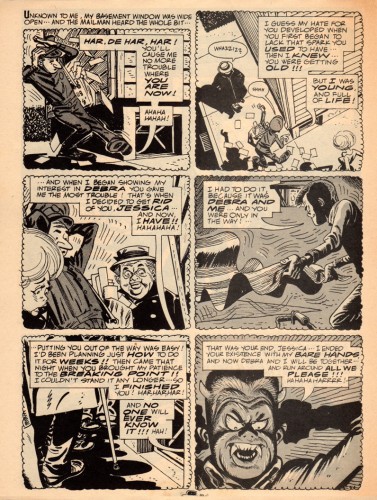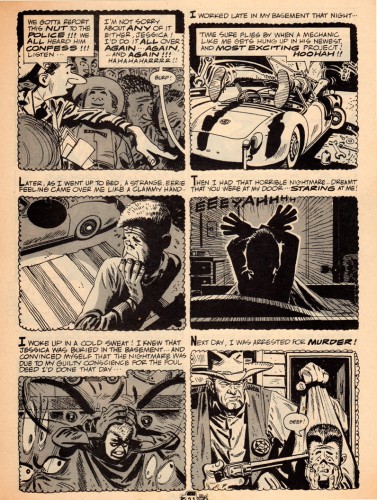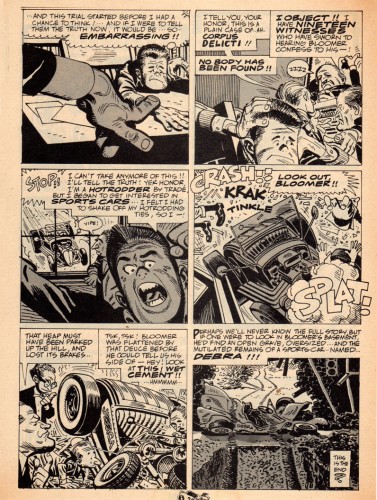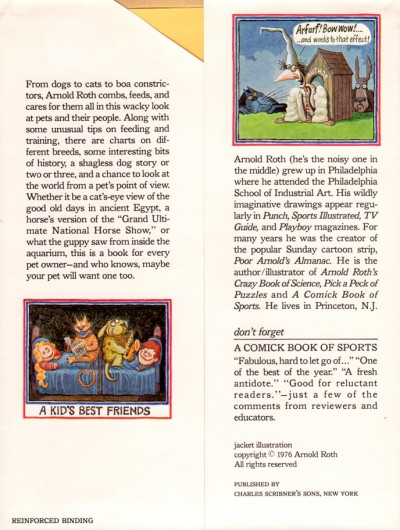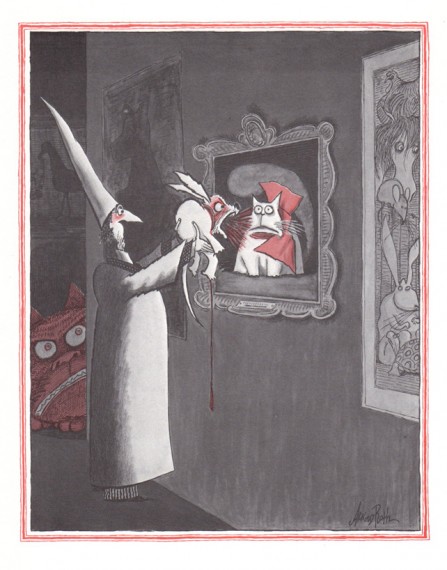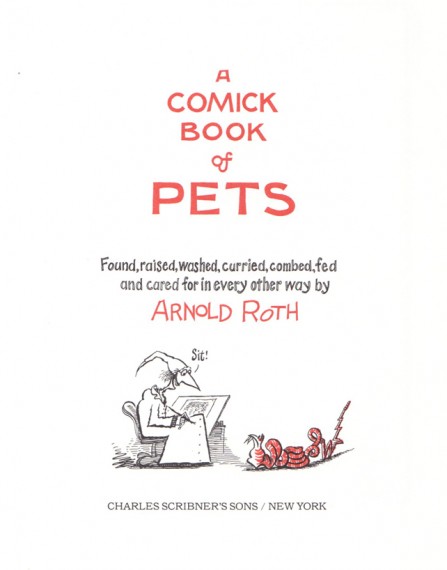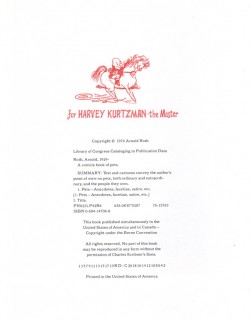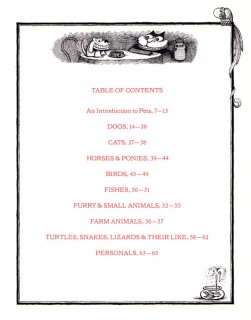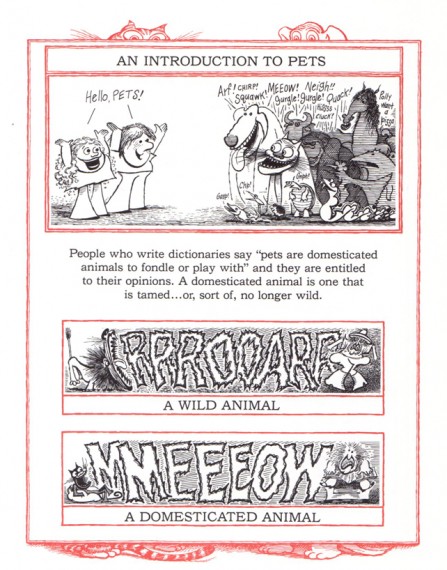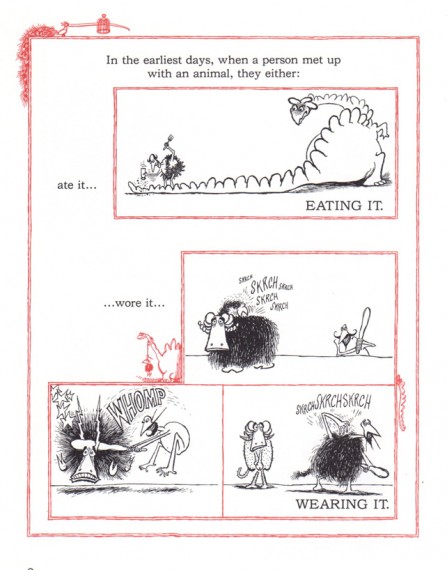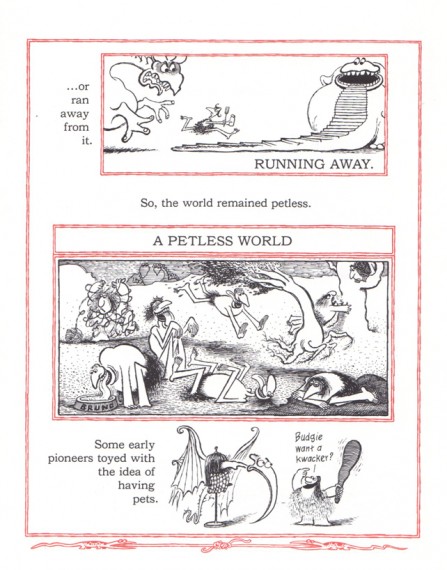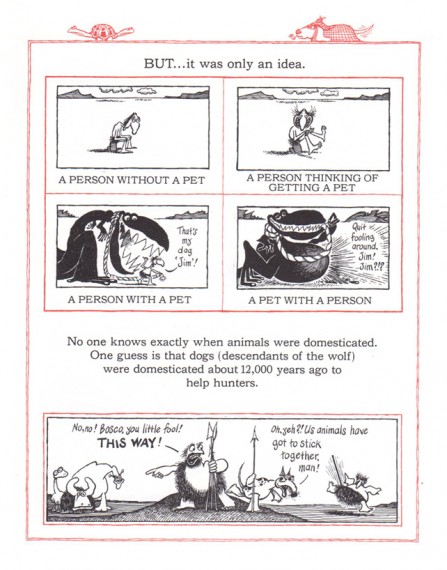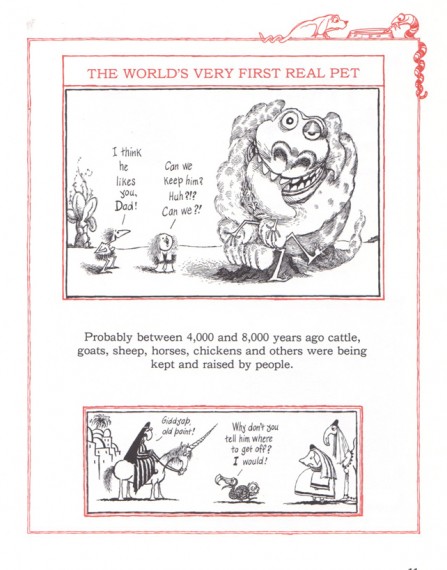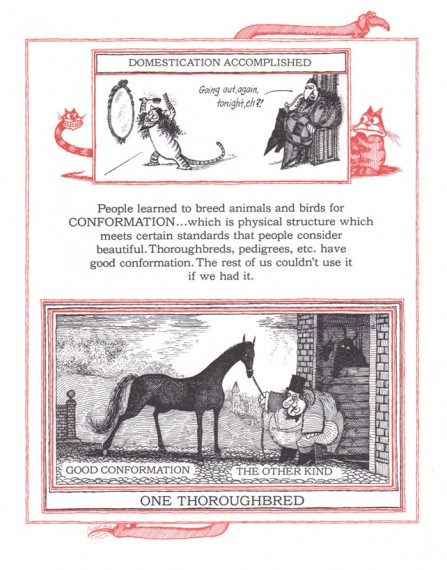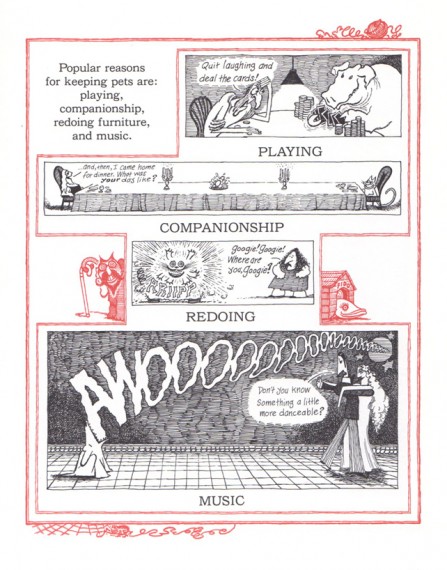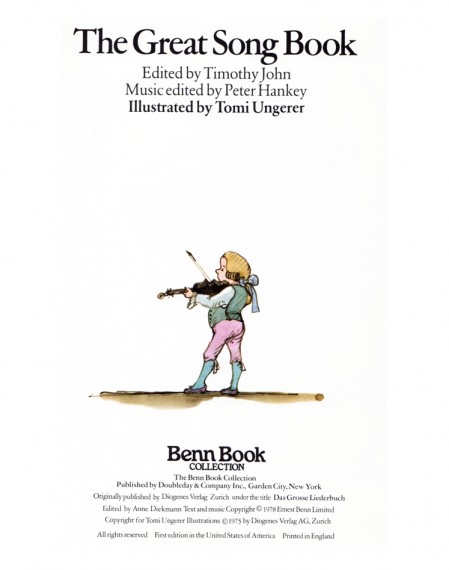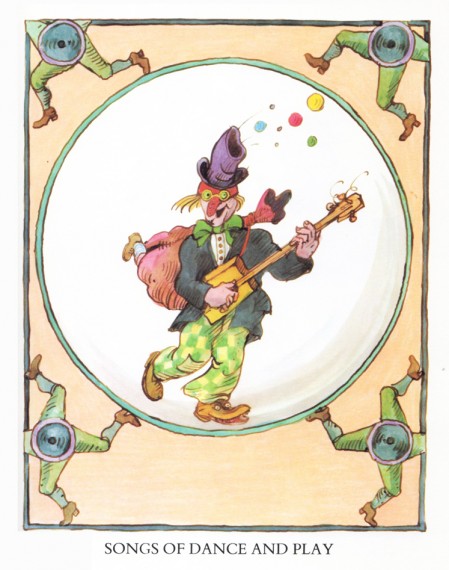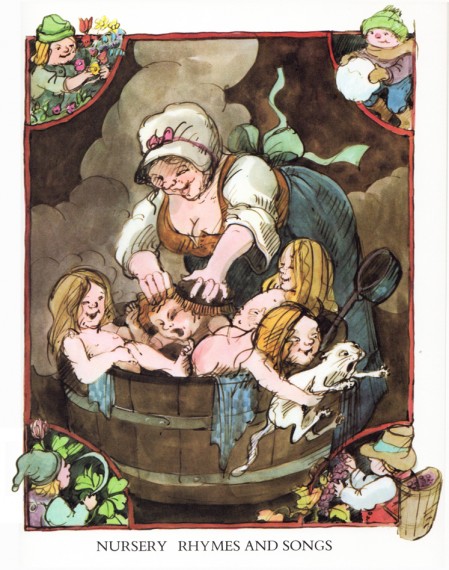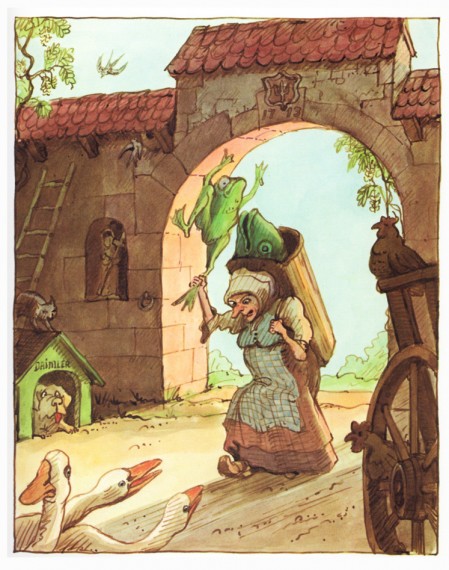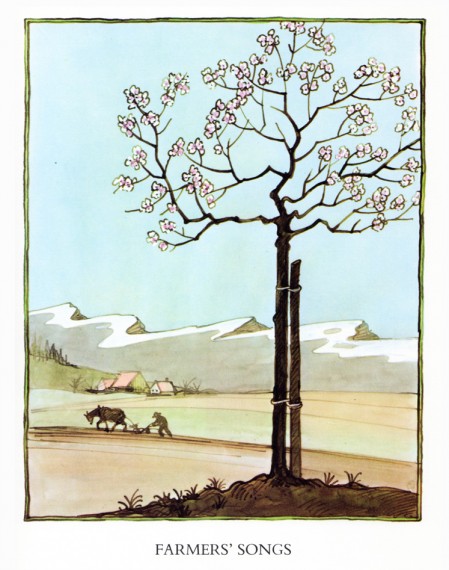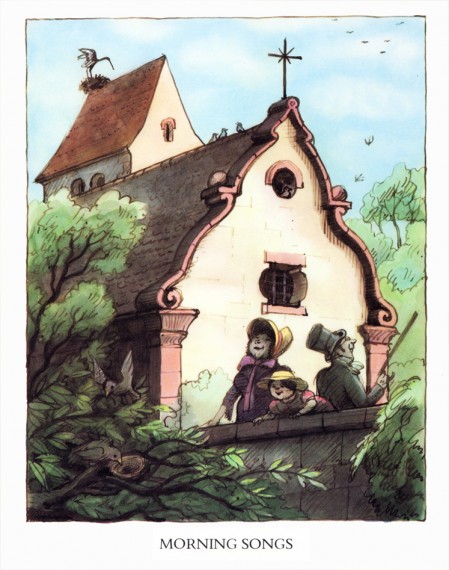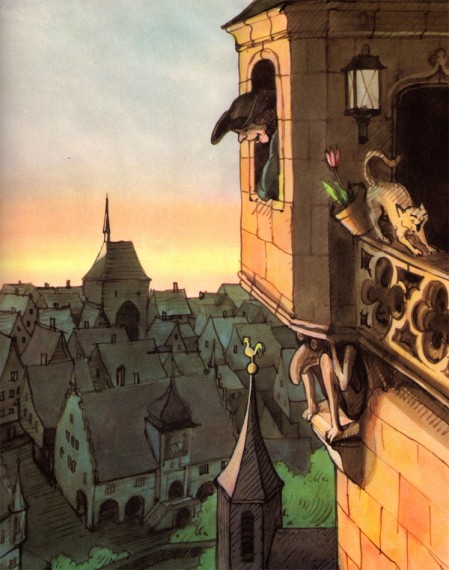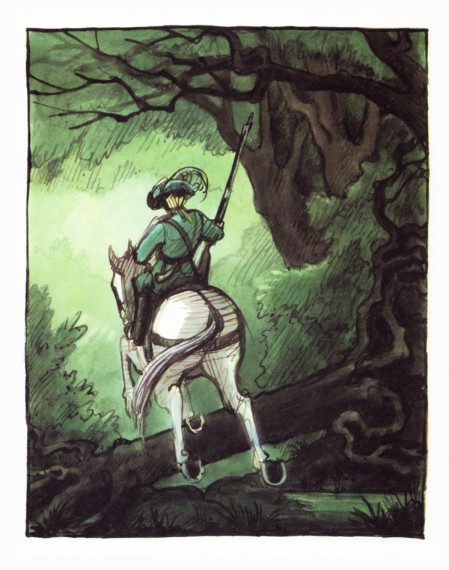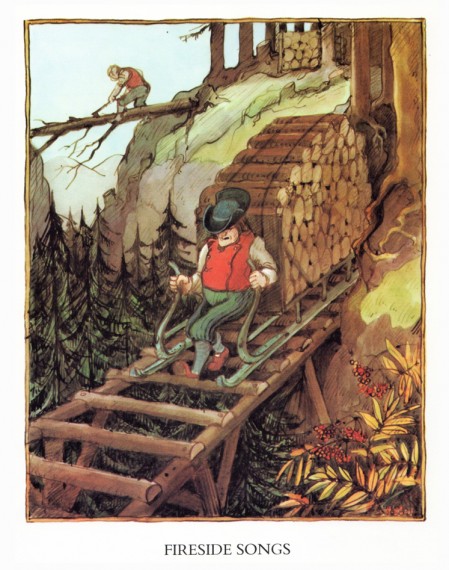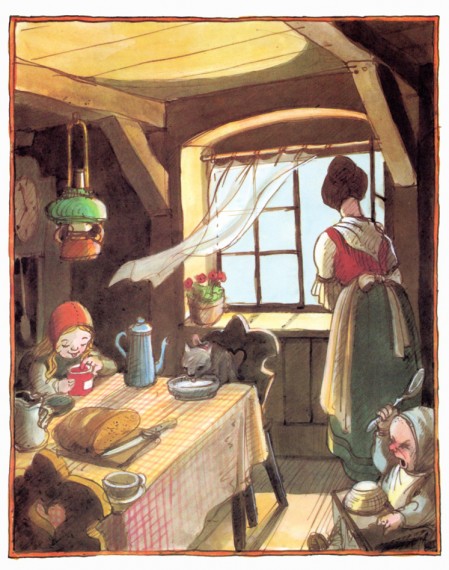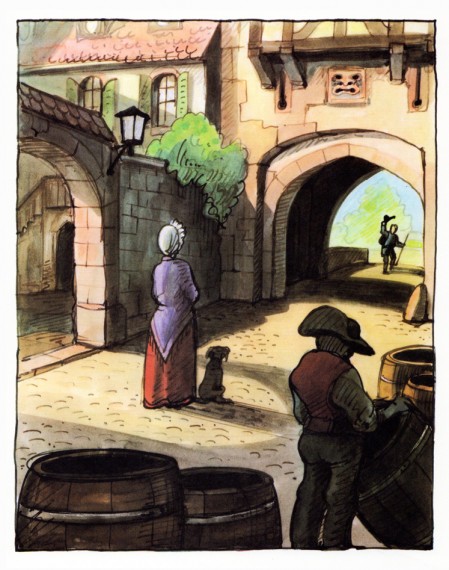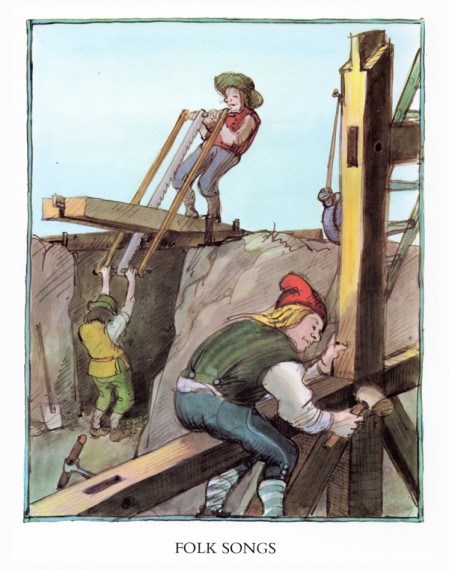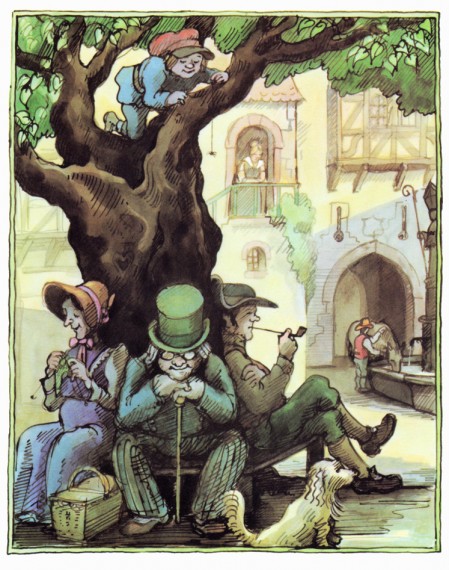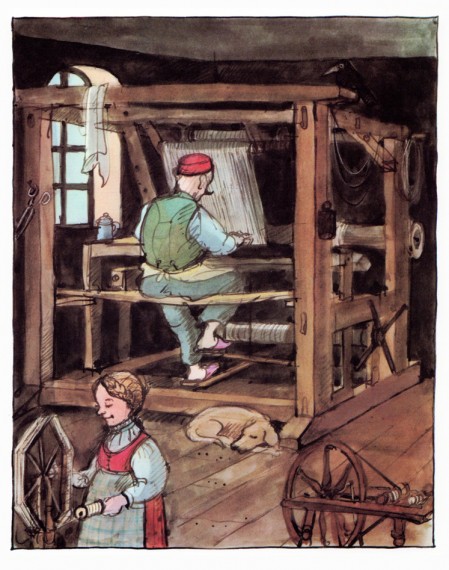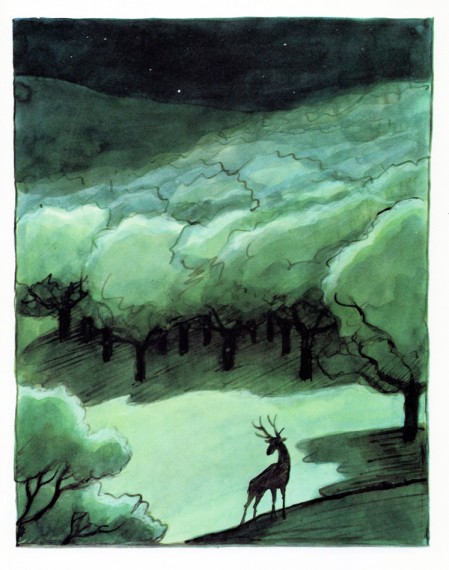Category ArchiveBooks
Bill Peckmann &Books &Illustration 17 Jun 2011 05:10 am
Vincent by Constantine – Pt.2
- Last week I posted the first part of this book by Greg Constantine, Vincent Van Gogh Visits New York. It was a paperback book Bill Peckmann bought in the ’80s. He introduced me to it and he scanned and sent the material to me.
Constantine also did Leonardo da Vinci Visits Los Angeles and Picasso Visits Chicago.
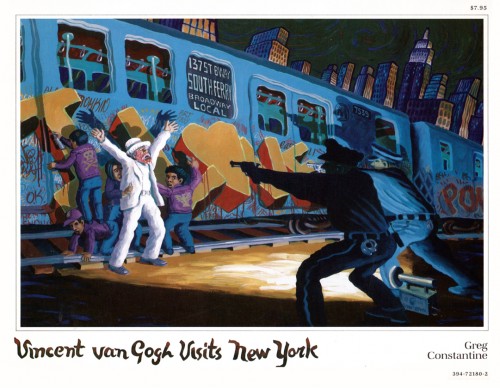
Cover
Many thanks to Bill Peckmann for sending this onto me to share.
Bill Peckmann &Books &Illustration 10 Jun 2011 07:50 am
Vincent by Constantine
- Bill Peckmann was reminded of this book by Hopper‘s Nighthawks painting on the last Hopper post we did. So he sent me some pages of Vincent Van Gogh Visits New York by Greg Constantine, a paperback book he bought in the ’80s. Constantine also did Leonardo da Vinci Visits Los Angeles and Picasso Visits Chicago.
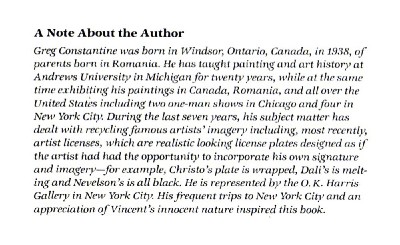
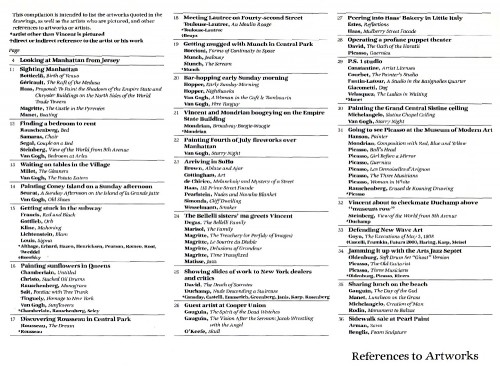
This is a guide the author gives us to artistic references throughout the book.
Thanks to Bill Peckmann for the scans and sharing the book with us.
Books &Commentary &Layout & Design &Theater 05 Jun 2011 07:08 am
Boris Aronson & the Yiddish Theater
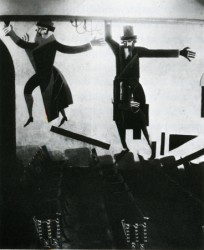 Back in 2007, Eddie Fitzgerald had an excellent piece on his site about the Yiddish Theater. This encouraged me, at the time, to write a post built on the back of some of the set designs of Boris Aronson, one of the greatest of all set designers for Broadway. I’ve added to it and recap it here.
Back in 2007, Eddie Fitzgerald had an excellent piece on his site about the Yiddish Theater. This encouraged me, at the time, to write a post built on the back of some of the set designs of Boris Aronson, one of the greatest of all set designers for Broadway. I’ve added to it and recap it here.
Most people have forgotten the theatrical heritage that came out of the Yiddish Theater. The immigrants to America brought a theatrical treasure with them. In New York, Second Avenue housed dozens of theaters that entertained a very large audience with hundreds of plays. The shows, of course, were all performed in Yiddish. These shows were not only in Manhattan but in the outer boroughs as well.
Many performers stepped out of Yiddish Theater into stardom, but there were also many directors, writers, composers and designers that emerged as well to create the history of the mainstream theater.
Boris Aronson, a Russian immigrant, designed for the Yiddish Unser Theater in the Bronx. He took his position as an opportunity to introduce Constructivist designs to audiences. New art was entering America at the popular level, and it was accepted.
Aronson did quite a number of set pieces and costume designs before moving over to the mainstream, English-speaking theater. He became the foremost designer on Broadway designing the original productions of many shows such as Cabin In The Sky, Bus Stop, The Crucible, and Awake and Sing. His later work included Cabaret, Fiddler On The Roof, Company, Follies and Zorba.
Here are a few examples of the work he did for the Yiddish Theater.
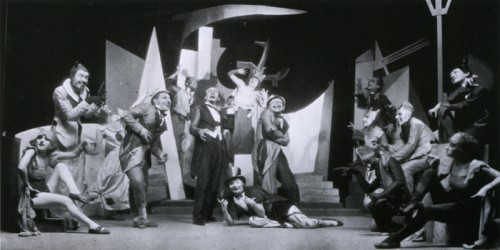
The above three images are from Aronson’s first production.
The Constructivist designs were for Ansky’s production of Day and Night (1924).
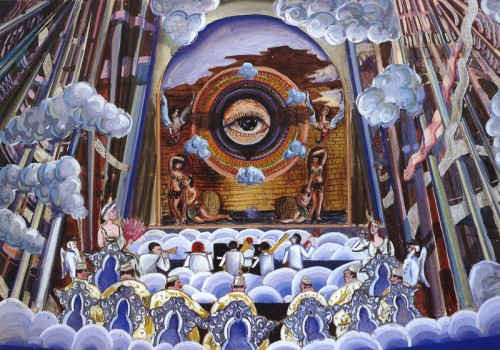
The allegorical plays of the Yiddish theater often featured Heaven and Hell.
Here, Aronson designed a “a concert hall in the skies of hell.”
The show was Maurice Schwartz’ production of “Angels on Earth”
for the Yiddish Theater in 1929.
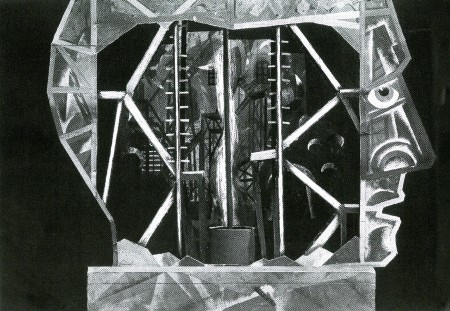
Here is his depiction of “Hell” in model form.
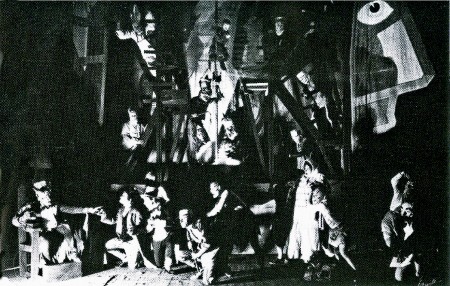
Here is the actual production of the “Hell” set.
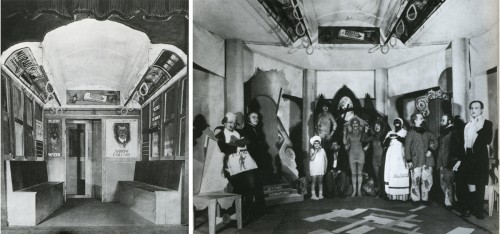
The show “The Bronx Express” required a subway car (left) with advertising cards.
A tired buttonmaker on his way home from work dreams that these ads come to life. (right)
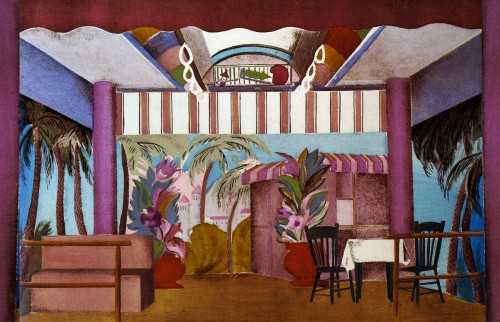
In the same show, the buttonmaker dreams of a beach resort boardwalk.
Aronson keeps the ceiling of the subway car intact for this set.
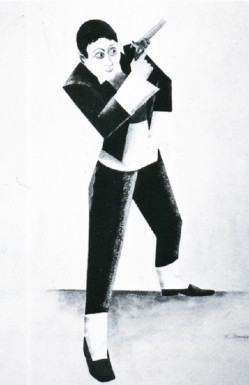
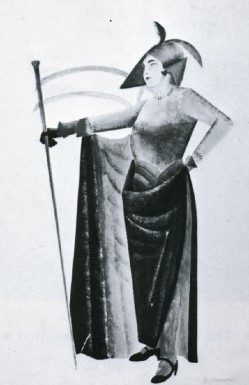
Designs for costumes for Joseph Buloff and Maurice Schwartz.
Books &Commentary &Disney 04 Jun 2011 06:52 am
Don Hahn’s Brainstorm & Other Brickabrack
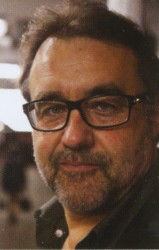 - Don Hahn is a busy guy. Aside from producing Beauty and the Beast, The Lion King and The Hunchback of Notre Dame, he’s produced the Disney nature documentaries Earth, Oceans and African Cats. He’s also directed Waking Sleeping Beauty about the renaissance of Disney animation.
- Don Hahn is a busy guy. Aside from producing Beauty and the Beast, The Lion King and The Hunchback of Notre Dame, he’s produced the Disney nature documentaries Earth, Oceans and African Cats. He’s also directed Waking Sleeping Beauty about the renaissance of Disney animation.
Mr. Hahn has also written a number of books, starting with Animation Magic through Disney’s Animation Kit as well as The Alchemy of Animation up to his most recent (non-picture) book, Brainstorm: Unleashing Your Creative Self.
I recently picked up Brainstorm and have read it, so I thought I’d write a few comments. I believe this is an updated and expanded version of the earlier book, Dancing Corn Dogs in the Night. In either incarnation, it’s an easy-to-read book with a light and casual sense of humor. Mr. Hahn is very comfortable in the skin of the light raconteur; he often tells stories that are witty and help to direct his point. This is a book about the creative process, and it tries to tell people how to get their artistic side out of their bodies.
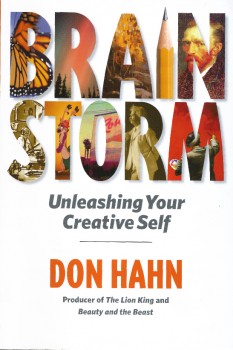 This process is best told in a story wherein a younger production manager calls Hahn in the evening asking to come up to his office. When they meet, the young executive says he needs advice: he’s trying to write a screenplay and is stuck. He wants Hahn’s advice as to how to get going. Hahn tells us that “the most successful writers write because they have to.” The conversation, he tells us, really came down to how much the writer “really felt he had to write.” Hahn says that he felt the writer had shortchanged himself; he needed the courage to be honest with himself and make big changes in his career path. “He had to be authentic.”
This process is best told in a story wherein a younger production manager calls Hahn in the evening asking to come up to his office. When they meet, the young executive says he needs advice: he’s trying to write a screenplay and is stuck. He wants Hahn’s advice as to how to get going. Hahn tells us that “the most successful writers write because they have to.” The conversation, he tells us, really came down to how much the writer “really felt he had to write.” Hahn says that he felt the writer had shortchanged himself; he needed the courage to be honest with himself and make big changes in his career path. “He had to be authentic.”
There are many such stories like this in the book, and they all feel authentic. It’s just that they all feel as though they’re adding up to be a Self-help book. There are many lines which I had to squirm through with ideas that no one would really have to tell an artist. The hardest line for me in the book is: “Shakespeare must have loved putting words together. He was like a phrase machine. If one guy was able to be that innovative with language in the sixteenth century, then why can’t we be more innovative?” The answer, of course, is that Shakespeare was the greatest living writer-as-artist that there ever was. He was a genius. I am not a genius, but I would never compare myself with Shakespeare. Maybe Stephen Sondheim might be comparable, but don’t ask me to be innovative so that I can be more like Shakespeare! I think of myself as someone trying my entire life to be an artist; I don’t have a problem being innovative, but I also can’t put myself in the same sentence with Shakespeare.
As such, I had a bit of a hard time reading it. I never in my life have had a hard time expressing myself artistically and have never needed advice on how to allow the muse to flow from myself. I don’t have a hard time getting started; more so I have a hard time stopping.
It was difficult for me to contain myself while reading a how-to book on the artistic process. “Art for Beginners” is not something I really needed to read, however the stories told kept me moving on through the book, and I’m sure they’ll entertain you as well. There’s the story of Dick Williams disappearing from his studio while preparing for a deadline in animating a scene, only to return very late in the deadline to whip it out. He had his own process of preparation. Or there’s the story of meeting Woolie Reitherman for the first time and hearing him call John Huston during the meeting (which leads to Hahn’s casual comparison between Reitherman and Huston.)
There are many stories we haven’t heard before, and for that alone, I felt the book was worth reading. I also appreciated that it might help some people to get the creative process going, if they are novices trying to think of themselves in artistic terms. I assume there are many such people out there.
2000
- This is the 2000th post I’ve put up.
No wonder my typing fingers are sore.
____________________
A Bad Start
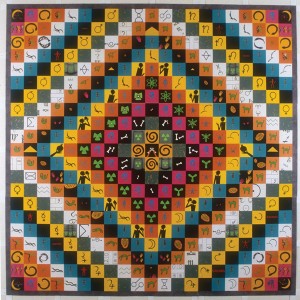 - Things started off roughly this week. First thing in the morning on Tuesday I was greeted with the news that Karen Aqua had died. It took a lot out of me that day. To lose so enormous a talent is difficult; to lose a friend in the animation community is even harder. We lost both with that email.
- Things started off roughly this week. First thing in the morning on Tuesday I was greeted with the news that Karen Aqua had died. It took a lot out of me that day. To lose so enormous a talent is difficult; to lose a friend in the animation community is even harder. We lost both with that email.
I posted my little post – not much more really, than Karen’s husband, Ken Field‘s telling of the news and information about a memorial service (when I know more about that I’ll pass the news on) – , but I found a wealth of Independent animators checking in to express thier feelings. Everyone from Candy Kugel to Kathy Rose, Joanna Priestly to Paul Glabicki. _____________Civilization by Karen Aqua
I realized with that open expression that there really is no place for the Independent animator to check in for news or stories about their work. Non studio artists are left to their own blogs and websites to promote their animation while multi-mega-budget films are given top headlines over whether or not they’ve broken the $100 million mark. It just doesn’t seem fair to me.
So I’ve decided to step tentatively into this water. I’m going to devote a day of the week (probably Tuesday or Thursday) to writing about some filmmaker/artist/animator. It’ll probably be a mix of reviews, interviews and bios of some of our best artists. Shameless promotion for the films that deserve more attention.
Independent animators: don’t hesitate to contact me if you have anything you’d like to promote or news you’d like to share or even if you’re just interested in having your films be a focus for a day.
- Speaking about that post, I was glad to see Cartoon Brew finally comment on Karen’s passing by directing people to my blog, but I was annoyed to see another blog lift my piece verbatim and post it on their site – not even separating my stills from their enlarged versions so that when you clicked a still it sent you to my site. Ordinarily, I wouldn’t mind, but I do like when they give my blog credit. Unfortunately, there was no naming of the origination of this post, and the blogger passed it off as if it were his own.
People, we have to have some modicum of courtesy out there !
I also contacted Ron Diamond at AWN to make sure they’d have a note about Karen on their site, (I knew they would, they’re usually just a tad slow in getting it done) and, indeed, they said one was in the works. It was posted that same day.
- The Holland Animation Film Festival has made a decision to move its date from Autumn to Spring. That means their next Festival will take place in the Spring of 2012, and there will be no Holland Animation Festival in 2011. The next edition is from 28 March through 1 April 2012.
I haven’t attended any of their Festivals, but for some reason I suspect this is one of the better ones out there. Maybe I should aim to go in 2012 if I can ever finish another film.
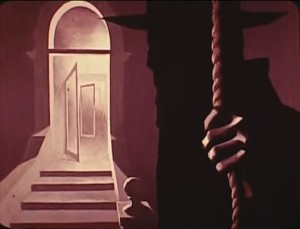 - Hans Bacher has posted a number of beautiful posts on Paul Julian‘s work on The Hangman, a film he directed in 1964. Go here and here to see the two already up and they will lead you to past posts on Julian’s work.
- Hans Bacher has posted a number of beautiful posts on Paul Julian‘s work on The Hangman, a film he directed in 1964. Go here and here to see the two already up and they will lead you to past posts on Julian’s work.
In the past, I’ve posted a couple of Julian’s books, Toot and Piccoli.
I’ve also done posts about Paul Julian‘s work for Roger Corman. You can see those posts here.
You can see a reddish print on YouTube here.
Bill Peckmann &Books &Comic Art &Illustration 03 Jun 2011 07:18 am
Mad Mad World
- Bill Peckmann forwarded the following material from Mad magazine taken from the collected Mad For Keeps. Here’s to Bill’s comments:
- Here’s a little something for all Harvey Kurtzman (writing and unseen rough lay outs) and Jack Davis (finished art) fans.
In 1958, Crown Publishers came out with the best of MAD collection. I believe this is the first hardcover collection of EC Comics to ever come out. Most of the book is comprised of MAD Magazine (started in ’55) stories and a few MAD Comic Book (’52 to ’55) stories.
Some of the comic book stories are printed in their original color, others without their original color. As far as I can tell, all of the work in here was written/rough laid out/edited by Harvey Kurtzman, MAD’s founder. It’s all copyrighted by EC Comics.
By the time the book came out it must have been a very bittersweet moment for Harvey because he had already left MAD, and MAD was just starting to become a commercial success. MAD went on to become an industry, rightfully so, but IMHO it never again was the “class” act that Harvey shepherded in. Also in retrospect, Kurtzman couldn’t have sustained that level for ever. After all, how many “Starry Nights” could Vincent paint?
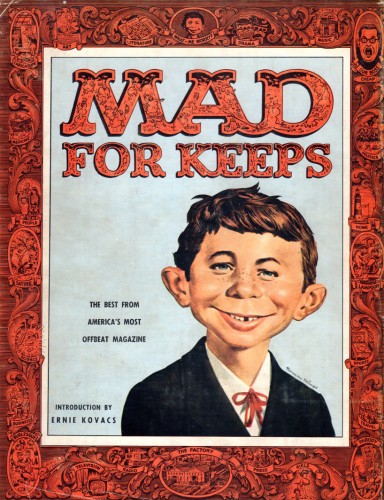 1
1We’ll start off with the cover, comprised from one of the issues,
which has Harvey’s great MAD logo, Bill Elder’s border and probably
Norman Mingo’s first Alfred E. Neuman illustration.
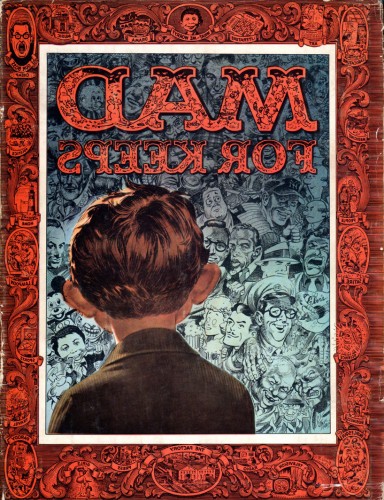 2
2
This is the back cover which Jack Davis embellished.
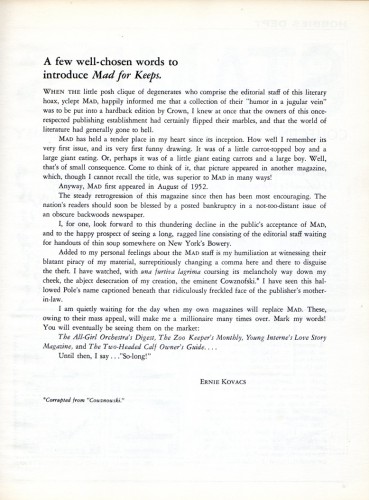 3
3
Here’s the book’s introduction by Ernie Kovacs.
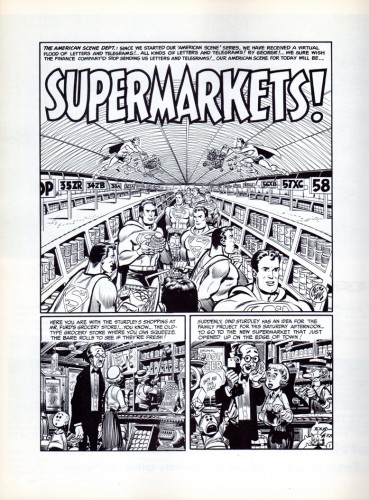 4
4
I thought with this book we would be able to show Jack Davis’ neat
transition from “comic book” art to “magazine illustration” art.
Again, during this time period, Jack is working over Harvey’s rough layouts.
Man, what a team! Sans coloring, you can really see Harvey’s storytelling and Jack’s beautiful brush & pen line work and his masterful spotting of “blacks”.
So here is the whole comic book story.
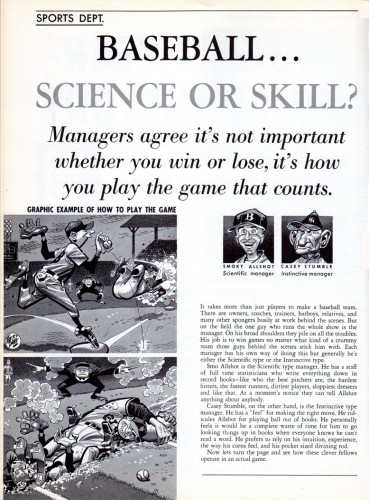 12
12
On to the “magazine” part. Look how sweetly Harvey laid this out,
add Jack’s hilarious art and you have perfection. Harvey always
compared Jack’s art to best strawberry ice cream sundae; I’ve
always seen it as the best sparkling jewelry ever, either way,
what eye candy!
ps: It doesn’t seem like baseball’s changed that much in 55 years.
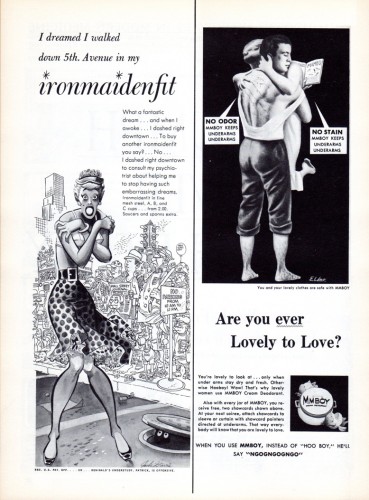 17
17
We’ll end on one of the early advertising spoofs and you can see
Jack is well on his way to becoming one of our national treasures.
Bill Peckmann &Books &Illustration 27 May 2011 07:01 am
Arnold Roth’s Cats
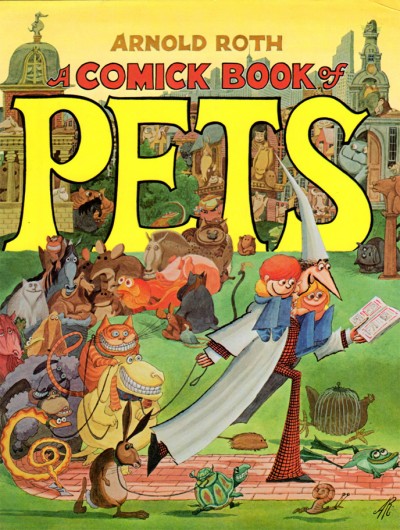
- You’ll remember that last week I posted a bit of Arnold Roth‘s brilliant book, A Comick Book of Pets.
Arnold Roth was born in 1929 in Philadelphia, Pa. He attended public schools and was awarded a scholarship to art school. He started free lancing in 1951 and continues to do so. Mr. Roth has had cartoons published in The New Yorker, Time Magazine, Sports Illustrated, Playboy, Punch and the NY Times. He’s worked briefly in animation for John Hubley and Phil Kimmelman. He currently lives in Manhattan with his wife and two sons.
Blessed Bill Peckmann has been feeding me some great scans of this book, and I’m ecstatic to be able to post them. This week, with the second part of the posting, we go out to all cat lovers (that includes me, I must say), and we present the chapter on “Cats”. The material’s pretty funny, and the drawings couldn’t be finer. I hope you enjoy.
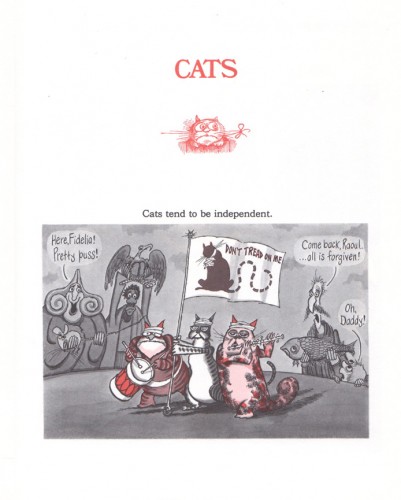 1
1
And as an additional bonus,
Bill Peckmann had this original ad which
Arnold Roth did for Phil Kimmelman & Ass.
Animation &Books 21 May 2011 07:18 am
Drawings From The Left
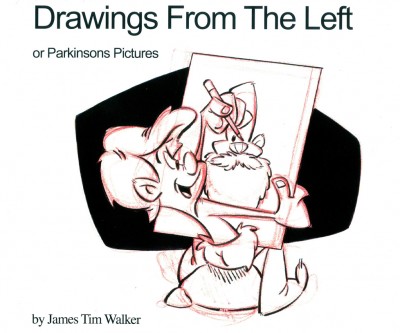
The book’s cover.
- Many years ago – I think I was 12 or 14 – I was consumed with animation and drawing. My parents took us ice skating. Of the brood of five children, I was the only one who refused to get on the ice. I purposefully brought my 8mm camera along. It was more important for me to record the event than to participate in it.
When I got home, I questioned my inactions. Why was it that I wouldn’t ice skate? I realized it was a deep fear that I would fall and someone would skate over my right hand, and I wouldn’t be able to draw again. That was when I religiously started trying to teach myself to draw left-handed. Every chance I got I put into that ice-skating fear by practicing left-handed drawing. It didn’t take long for me to stop trying. I could see some small progress in what I was trying to draw and left it at that.
 This psycho-memory of mine flashed across my brain recently when I discovered James Tim Walker‘s book, Drawings From The Left or Parkinsons Pictures. I received a call from Tim and a copy of his book soon thereafter.
This psycho-memory of mine flashed across my brain recently when I discovered James Tim Walker‘s book, Drawings From The Left or Parkinsons Pictures. I received a call from Tim and a copy of his book soon thereafter.
The book really looks like a sketch book. In fact, when I took it from the envelope I actually wondered if it was an original or had it actually been printed. The textures on the cover made the pen and ink over red pencil drawings look real. After running my finger over it, I realized that it was published.
I’d read about Tim’s story on Cartoon Brew and The Blackwing Diaries, and I was curious to see the book. I’d looked around a couple of shops in NY but hadn’t seen a copy to peruse. I knew it was for sale on Amazon, but I like thumbing through books before I buy one.
Tim had been an artist, animator and director for many of the LA studios and had a rich and solid career. Then Parkinson’s disease hit him. (Since my father died of complications from Parkinson’s, I’m all too familiar with the debilitating disease.) Tim has Lateral Parkinson’s, meaning only one side of his body was affected. Naturally, this was the right side, and the right-handed Tim had to face up to the fact that he wouldn’t be able to draw again – unless he taught himself to draw left-handed.
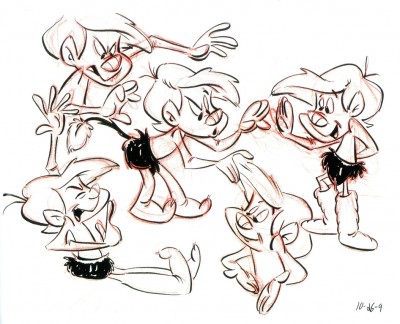
A good example of the many drawings by Tim in his book.
Four years later, and this book of Tim’s “Left-handed drawings” was published. The drawings are all bouyant and lively cartoons of a series of original characters. They’re all posed in many positions, like model sheets, showing the versatility of an animator at work. There’s as much life here as in any of Fred Moore’s drawings. As a matter of fact, I learned from Jenny Lerew’s site The Blackwing Diaries, that Tim is a fan of Fred Moore’s work and has a collection of Moore art.
It’s a testament to the strength and endurance of a solid artist to be able to overcome the difficulties life has dumped on him. As a matter of fact, I think in some way that anyone who has made a career out of animation is practising this same endurance, albeit on a smaller level, to overcome the odds of a changeable industry.
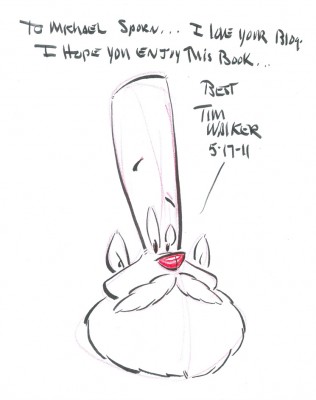
The page that Tim drew and autographed for me.
Bill Peckmann &Books &Comic Art &Illustration 20 May 2011 06:50 am
Early Toth
- Bill Peckmann sent some fresh Alex Toth material and with it came some notes. So, I’ll turn the blog over to him today:
- In keeping with the celebration of Dean Mullaney‘s book, Genius Isolated, I thought I’d scan some of Alex’s early 1950′s and early 1960′s comic book art.
The first three are DC Comics’ “All American Western” covers from 1949 to 1951. (Wonderful house/publisher coloring.) The character he was doing for the book was called “Johnny Thunder”, a western hero with a Clark Kent duel personality. Alex was only 21 years old at the time of the first cover.
(#121 has been reprinted in “Genius”)
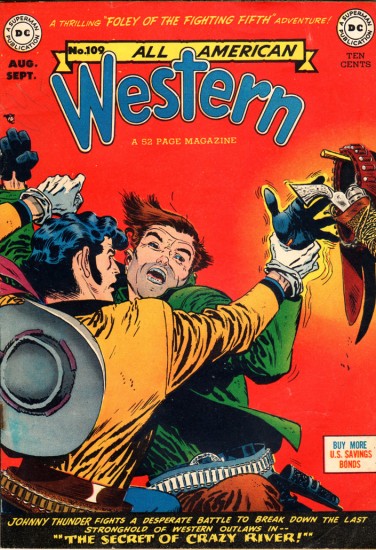 1
1
- The following is the back cover of issue #121, it’s an ad, non Toth, I just thought you’d get a kick out of it. . . .
. . . As an 8 year old I remember this premium/give away very well, Donald and Mickey were the prized ones of course. To all us little cookie snappers at that time, anything Disney was few and far between, unlike today!
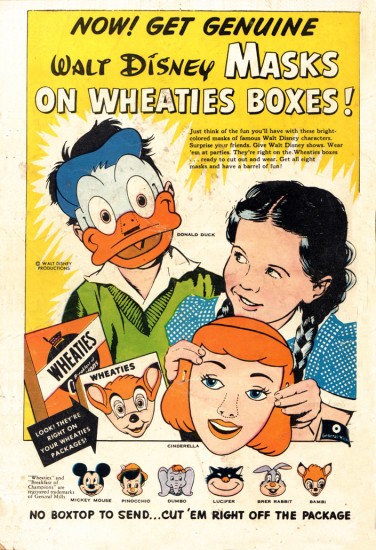
- The following complete story is from EC Comics’ “Two-Fisted Tales”, issue #22, 1951. (This scan is of the cover done by book editor Harvey Kurtzman.)
The story “Dying City” was written, layed out and outstandingly inked by Harvey Kurtzman. The beautiful tight pencils were Alex’s. Both gents were in their best Milton Caniff mode, wonderful job of a very grim story.
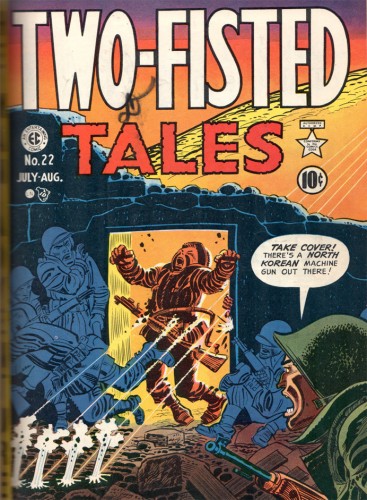 1
1
- In 1963 Alex was doing “Mad Magazine” type pages for “cartoon car” type magazines coming out of the west coast. It looks like he had an easy time slipping into the skins of Jack Davis and Mort Drucker and seemed to enjoy doing it for a while. These 2 stories are from “DRAG CARtoons” #2. They are take offs of the then popular TV series, “Dr. Kildare” and “The Defenders.
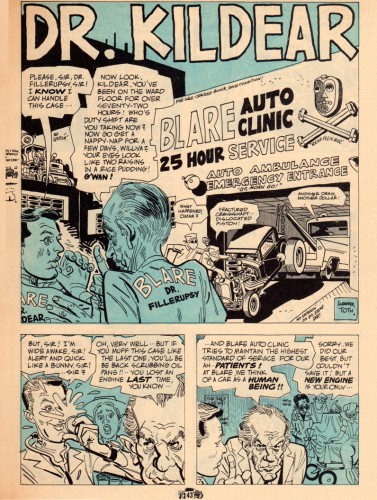 1
1
- Both these stories plus all of the rest of this type that Alex did for the “cartoon car” magazines were lovingly and handsomely collected by Manuel Auad (publisher of the new, excellent Robert Fawcett book) in his/this Alex Toth, One for the Road, published in 2000.
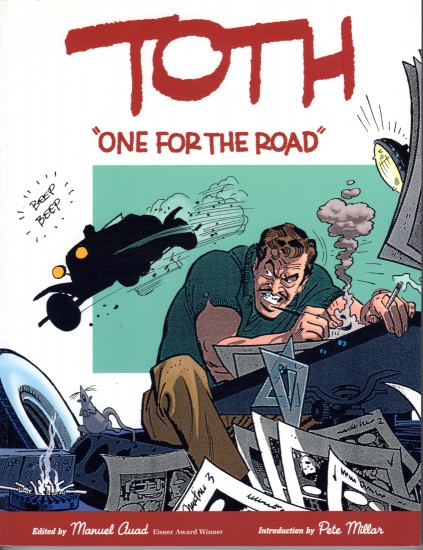
Cover – “One for the Road”
Many thanks to Bill Peckmann for all the great material in this post.
Books &Illustration 17 May 2011 06:42 am
Roth’s Comick Book of Pets
- Here are some pages from Arnold Roth‘s Comick Book of Pets. These pages were sent to me by Bill Peckmann. It’s a beautifully layed-out book.

The front cover
Many thanks to Bill Peckmann for sending the scans. Roth’s art and sense of humor have always been a favorite of mine.
Bill Peckmann &Books &Illustration 10 May 2011 07:48 am
Ungerer SongBook
- Here’s a precious item scanned and sent to me by Bill Peckmann. It’s a song book that Tomi Ungerer illustrated. Back in the 70s, Ungerer‘s work was everywhere. As a matter of fact, I always seemed to take it for granted. Yet, everytime I came upon one of his brilliant children’s books, I would find him anew. Always the work was excellent with a depth that you rarely found except in the best of Sendak or Glaser.
This song book, published in 1975, is filled with fine illustrations by Mr. Ungerer. This is a style whose depths he plumbed in ths period with books like Strega Nonna or The Three Robbers. Unlike much of his earliest work, it seemed less cartoon and more Bruegel.
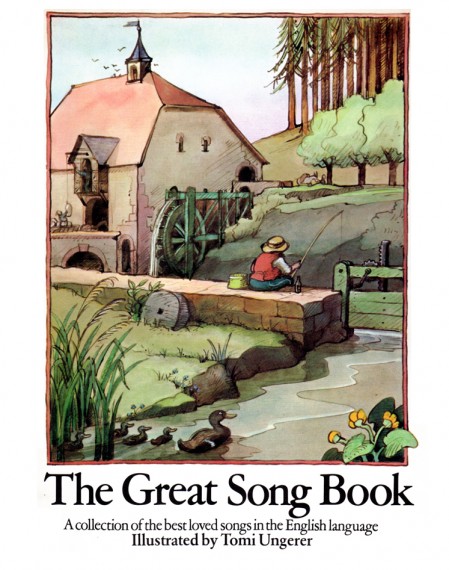
The book’s cover
Many thanks to Bill Peckmann for contributing this artwork, scans and inspiration.
